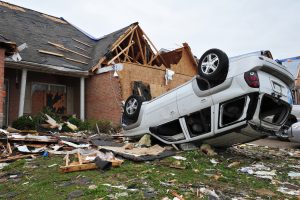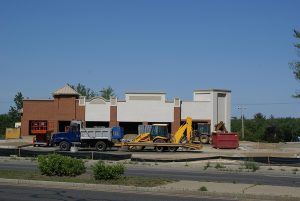The right type of roof is important to the structure and aesthetic of your home. Choosing the right roof types can be a little harder than you think. Recently, we went over some types of roofs and today we are here with Part 2 to ensure you make the best decision for yourself, your family, and your home. Check them out.
Skillion Roof
A skillion roof is a single, sloping roof, usually attached to a taller wall. It’s also referred to as a shed roof or lean-to. We can think it of as half of a pitched roof, or as a more angled flat roof. They mostly use skillion roofs for home additions, sheds, and porches. However, they are also now being used on the entire structure of more modern-style homes.
Pros:
Skillions are easy to assemble and use much fewer building materials than other roof types. Their steep pitch allows snow and water to easily run off, which makes them excellent for high rain and snow regions. Skillions can also be used purely for design to add architectural interest and aesthetic appeal.
Cons:
If the roof pitch is too high, it can cause ceilings to be too low. Also, homes using only a skillion roof can have problems in high wind areas.
Jerkinhead Roof
A Jerkinhead roof uses elements of both gable and hip roofs. We can think of it as a gable roof with hipped ends. Or, we can describe it as a hip roof with two short sides. They may also be referred to as clipped gable or English hip roofs.
Pros:
Jerkinhead roofs are more stable than regular gable roofs. By clipping, or turning the point down, the roof becomes more resistant to wind damage. They also provide more space than a traditional hip roof. The higher pitch offers more living space while providing better reinforcement.
Cons:
The complex design will make building costs higher.
Butterfly Roof
A butterfly is a V-shaped roof constructed of two pieces that are angled up on the outside. The midsection is angled downward where the two pieces meet into a valley. It looks like a butterfly with its wings in flight. A butterfly roof is popular for modern, eco-friendly, and tropical home designs.
Pros:
The upper angle of the outer edges allows larger windows to be used. This gives the home more natural light, lower heating bills in the winter, and brings an open feel to the design.
The valley in the butterfly’s midsection roof allows rainwater to be collected, making it beneficial for high drought areas. We usually install a downspout or other type of water reservoir for this purpose. The butterfly roof lends itself to an environmentally friendly home design, as solar panels, water collection systems, and natural light can all be easily incorporated into it.
Cons:
The complexity of the design makes the butterfly roof more expensive. Not only are the upfront costs higher than with conventional roofs, but the maintenance will also be more expensive.
Ensuring the butterfly roof is waterproof is essential. Drainage systems can get clogged, causing water to pool or leak. This will weaken the pillars over time, which can cause the roof to collapse. The open design and tall windows can make it more difficult to regulate the temperature throughout the home. As a result, some areas may be much warmer than others.
Bonnet Roof
Bonnet roofs, also known as kicked eaves, are double sloped with the lower slope set at less of an angle than the upper slope. It’s like a reverse Mansard. The lower slope hangs over the side of the house. This overhang is an excellent cover for an open porch. Bonnet roofs are not commonly used roofs in modern houses. They were mainly used in French Vernacular and can be seen in regions of Louisiana and Mississippi.
Pros:
The upper slope provides extra living space for a small attic or vaulted ceilings. It also lends itself to dormers or side windows. The overhanging eaves not only protect porches but also help to protect walls from water damage. Water easily runs off the slopes of the roof and the modified hip structure makes it more durable than a gable roof.
Cons:
The complex design requires more building materials, and it’s more difficult to construct. This makes the bonnet roof more expensive than other, more simple designs.
Although water easily runs off the slopes, valleys are formed where the two slopes meet. This can cause snow and water to pool. Extra precaution is necessary to waterproof these areas.
Saltbox Roof
A saltbox roof is asymmetrical in design, with one side being more of a slightly sloping flat roof and the other more of a lean-to, with gables at each end. Saltbox houses are variations of early Colonial and Cape Cod designs. They arose from the need for more room. Early Americans realized they could add more space with less material by adding a lean-to roof to an existing gable roof. Soon, homes were built with the lean-to roof already added.
Pros:
The slope makes it easy for water to run off, making the saltbox roof good for areas that receive heavy rain. The asymmetrical design makes it more durable than a simple gable roof. It adds more living space by making a home one and a half to two stories.
Cons:
The design can be tricky, which makes the building costs higher. Although it provides more living space, it isn’t as much as a regular pitched roof. Also, some rooms may have slanted ceilings.
Sawtooth Roof
A sawtooth roof is two or more parallel pitched roofs in which the sloped and vertical surfaces alternate. As the name suggests, the roof resembles the side view of a saw blade. They once only used sawtooth roofs on commercial and industrial buildings. However, now we use them in modern home design.
Pros:
They place windows in the vertical spaces of the roof, allowing more natural light inside the home. The higher peaks provide the opportunity for either vaulted ceilings or loft living space. The combination of the various slopes and use of natural light make this design an excellent choice for homes with environmentally friendly conveniences, such as solar panels, geothermal and radiant heating systems.
Cons:
The complex design and various building materials needed will make the sawtooth roof much more expensive than other roof types. It’s also a high-maintenance roof.
Additionally, adding windows, valleys, and varying slopes creates a higher chance for water leaks. Because of this, sawtooth roofs aren’t advisable in heavy snowfall areas.
Curved Roof
A curved roof is much like the Skillion roof but the planes are curved. It is very modern and provides a unique, creative roof design. The amount of curve can vary from slightly curved up to an arch shape.
Pros:
Curved roofs are aesthetically pleasing and a way to have a home unlike any other. They also provide subtle shapes inside the home as well. A curved roof can be used to cover the entire home or a single section, such as an arched entrance. Since the architect or builder designs the roofs, we can customize them to be helpful to the region the home is being built.
Cons:
The cost of a curved roof depends on the complexity of the design. The more complex a design, the more expensive it will be.
Pyramid Roof
A pyramid roof is a type of hip roof. All four sides come to a point at the top of the roof. There are no vertical sides or gables. They mostly use pyramid roofs for smaller buildings, such as bungalows and cabins. We also use them for auxiliary structures, such as pool houses, garages, and storage buildings.
Pros:
A pyramid roof is extremely resistant to strong winds. This makes it an excellent architectural choice for hurricane-prone and high-wind areas. The slope provides extra space for ventilation, attics, or high ceilings. Plus, the overhanging eaves will reduce energy costs.
Cons:
The cost of pyramid roofs is higher due to the complexity of the design.
Dome Roof
A dome roof is polygonal with an inverted bowl shape. Dome roofs are great for adding unique and aesthetically pleasing features to any home. They are excellent choices for cupolas, gazebos, or crow’s nests.
Pros:
Dome roofs are both beautiful in design and durable.
Cons:
The complexity of a dome roof makes them expensive to construct. However, depending on the structure, a prefabricated one may be available.
Final Thoughts
When choosing roof types, you must first determine what will and what won’t work in your area. For example, a high-pitched roof can be one of the most practical options if you live in a snowy area.
Once you’ve figured this out, consider your needs. Do you need extra space, or would you rather have an environmentally friendly down?
Lastly, decide on the style. Take these factors into consideration and you will have to roof and home of your dreams. If you are ready to take this step now, call us at 636-699-0449.





